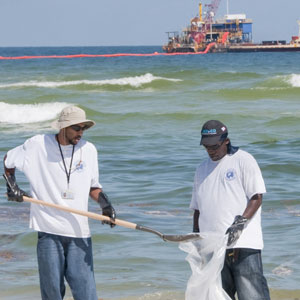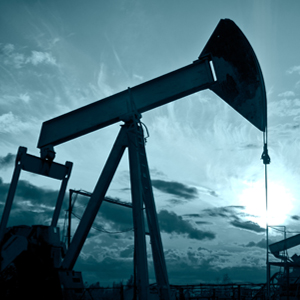In a just-released monograph, NIEHS Gulf Long-term Follow-up (GuLF) Study researchers describe the extraordinary work that went into developing inhalation and dermal exposure estimates for people involved in oil spill response and cleanup after the 2010 Deepwater Horizon oil spill in the Gulf of Mexico. The GuLF Study is following these workers over time to evaluate potential short- and long-term health effects.
 Sandler frequently mentors aspiring young scientists, from the undergraduate level to beyond the doctoral dissertation. (Photo courtesy of Steve McCaw / NIEHS)
Sandler frequently mentors aspiring young scientists, from the undergraduate level to beyond the doctoral dissertation. (Photo courtesy of Steve McCaw / NIEHS)Papers included in the monograph describe the statistical and methodological underpinnings of the exposure estimates that were developed. The scientists highlight approaches for dealing with large amounts of missing data, sources of data used to generate estimates, and theoretical models that were developed to describe exposures that could not be directly measured. Reports include exposure levels of six components of crude oil and fine particulate matter (PM2.5) produced by the burning and flaring of oil and natural gas. The work results from 10 years of research.
“This was the largest oil spill in the United States, and no oil spill study has ever undertaken an exposure assessment project as extensive as ours,” said Dale Sandler, Ph.D., senior investigator and chief of the NIEHS Epidemiology Branch, who leads the study. “This is a monumental accomplishment by our exposure assessment team.”
For example, the researchers found that workers on all vessels associated with the oil rig, fire control, research, and other water operations had some level of exposure to the compound benzene — a known carcinogen.
With information on which job roles may be most vulnerable, those responsible for oil spill cleanup work can better plan how to protect workers from similar exposure scenarios, said Kaitlyn Lawrence, Ph.D., a staff scientist in the NIEHS Chronic Disease Epidemiology Group. She began working on the GuLF Study in 2014 as a summer intern, and under the mentorship of Sandler, she completed her doctoral dissertation on the impact of oil spill exposures on lung function using GuLF Study data.
Now the exposure methods and findings will be accessible to researchers and policymakers in a single publication, said Sandler. The monograph is published in the journal Annals of Work Exposures and Health.
Quantifying exposure risks
The GuLF Study has been a national effort conducted by NIEHS to determine whether the Deepwater Horizon spill led to physical or mental health problems in response workers.
Measured across a changing landscape of ad hoc response and cleanup work, the exposure assessment breaks new ground by quantifying workers’ exposures following a massive industrial disaster, said Lawrence.
 Lawrence plans to expand her research into studies of neighborhood factors on epigenetic markers of aging. (Photo courtesy of Steve McCaw / NIEHS)
Lawrence plans to expand her research into studies of neighborhood factors on epigenetic markers of aging. (Photo courtesy of Steve McCaw / NIEHS)“One would be hard-pressed to find this level of detailed exposure assessment following occupationally-related disaster exposures of any type,” Lawrence added. “This monograph should be looked to as a model for any future similar industrial hygiene effort.”
In the years after the Deepwater Horizon disaster, workers who participated in the cleanup effort experienced increased risk of developing hypertension, also known as high blood pressure. They also experienced mental health problems, such as post-traumatic stress disorder and depression; decreased lung function; heart disease; and a range of symptoms consistent with neurological and respiratory disease effects, according to previous papers resulting from the GuLF Study.
The new exposure data will allow GuLF researchers to address questions “about health risks associated with specific components of crude oil known to be hazardous, addressing a major gap in the literature,” said Lawrence.
Developing new statistical methods
The research team adapted industrial hygiene techniques to define exposure groups based on information about both inhalation and skin contact exposures to oil components over varying time windows during the cleanup effort. Assessments took place over a broad geographic area in the Gulf of Mexico and along the coast of five Gulf of Mexico states. Workers’ exposures varied with weather and location, and over time. Health effects also depended on responders’ job tasks and time worked.
In addition, the scientists used statistical methods that allowed them to assign exposure levels to all workers participating in the GuLF Study. To accomplish this, they combined air exposure measurements taken at the time of the spill, the team’s modeling of exposures not measured at the time of the spill or afterward, and individuals’ descriptions of their cleanup-related jobs, according to Sandler.
Oil spills around the world
With a continuing need for oil cleanup operations around the globe as accidents occur, many people may be exposed in cleanup efforts. Data from the U.S. National Oceanic and Atmospheric Administration Office of Response and Restoration show that the office responded to 139 incidents in the first 10.5 months of 2021.
Of those cases, 108 were categorized as involving oil. Many were small incidents, but some were larger spills — such as the California coast exposure on Oct. 2, 2021, which involved 140,000-plus gallons of crude oil. Although media coverage following many of these spills often focuses on wildlife effects, workers are always present to respond and potentially be exposed, said Sandler. She added that due to the unprecedented size and scope of the Deepwater Horizon oil spill, the media did pay significant attention to the exposure and health concerns of persons affected by the disaster, which in part prompted the GuLF Study.
Citation: Stewart P, Groth CP, Huynh TB, Gorman Ng M, Pratt GC, Arnold SF, Ramachandran G, Banerjee S, Cherrie JW, Christenbury K, Kwok RK, Blair A, Engel LS, Sandler DP, Stenzel MR. 2022. Assessing exposures from the Deepwater Horizon oil spill response and clean-up. Ann Work Expo Health 66(Supplement_1):i3–i22.
(Catherine Arnold is a contract writer for the NIEHS Office of Communications and Public Liaison.)









